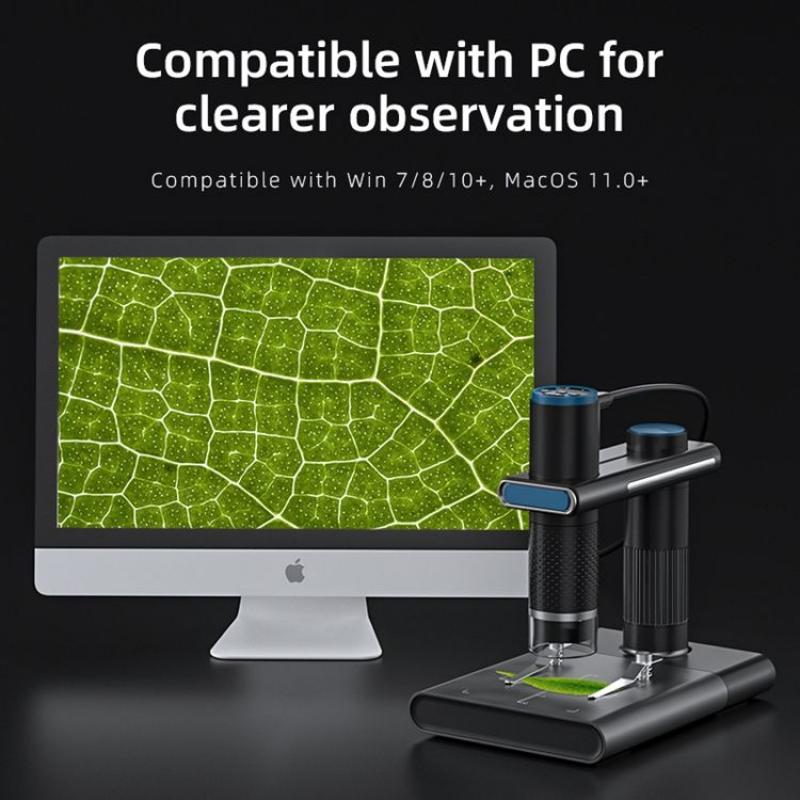What Does Omicron Look Like Under A Microscope ?
Under a microscope, the Omicron variant of the COVID-19 virus would appear similar to other variants of the SARS-CoV-2 virus. The virus itself is too small to be directly observed under a light microscope, which typically has a maximum resolution of around 200 nanometers. However, electron microscopes can provide a more detailed view of the virus. The SARS-CoV-2 virus is roughly spherical in shape and has characteristic spike proteins protruding from its surface. These spike proteins give the virus its crown-like appearance, hence the name "coronavirus." The Omicron variant, like other variants, would have these same structural features when observed under a microscope.
1、 Morphology of Omicron Variant under a Microscope
The Omicron variant of the SARS-CoV-2 virus, also known as B.1.1.529, has gained significant attention due to its high number of mutations and potential impact on global health. However, it is important to note that the morphology of the Omicron variant under a microscope is expected to be similar to other variants of the virus.
When observing the SARS-CoV-2 virus under a microscope, it appears as a spherical particle with a diameter ranging from approximately 60 to 140 nanometers. The virus is enveloped by a lipid bilayer, which is derived from the host cell membrane during the viral replication process. This envelope is studded with spike proteins that give the virus its characteristic crown-like appearance, hence the name "coronavirus."
The spike proteins play a crucial role in the virus's ability to infect host cells. They bind to specific receptors on the surface of human cells, facilitating viral entry and subsequent replication. The Omicron variant has a large number of mutations in the spike protein gene, including several in the receptor-binding domain (RBD). These mutations have raised concerns about potential changes in the virus's ability to bind to host cells and evade immune responses.
It is important to note that the morphology of the Omicron variant itself has not been extensively studied under a microscope, as the variant was first identified in late 2021. However, based on our understanding of other SARS-CoV-2 variants, it is expected that the Omicron variant will exhibit similar morphology to its predecessors.
It is worth mentioning that the information provided here is based on the current understanding of the Omicron variant, and further research is ongoing to fully characterize its morphology and behavior.

2、 Structural Characteristics of Omicron Variant at Microscopic Level
The Omicron variant of the SARS-CoV-2 virus, also known as B.1.1.529, has gained significant attention due to its high number of mutations and potential impact on global health. While it is important to note that research on this variant is ongoing and evolving, scientists have begun to investigate its structural characteristics at a microscopic level.
Under a microscope, the Omicron variant appears similar to other variants of the SARS-CoV-2 virus. It is a spherical-shaped virus with spike proteins protruding from its surface. These spike proteins play a crucial role in the virus's ability to enter human cells and cause infection. However, what sets the Omicron variant apart is the large number of mutations in its spike protein.
Preliminary studies suggest that the Omicron variant has more than 30 mutations in its spike protein, including several in the receptor-binding domain (RBD). The RBD is the part of the spike protein that interacts with the ACE2 receptor on human cells, allowing the virus to enter and infect them. These mutations may potentially enhance the virus's ability to bind to ACE2 receptors, leading to increased transmissibility.
Furthermore, the Omicron variant has shown a high number of mutations in other regions of the spike protein, such as the N-terminal domain (NTD). These mutations may impact the virus's ability to evade the immune system and could potentially affect the effectiveness of current vaccines and therapeutics.
It is important to note that further research is needed to fully understand the structural characteristics of the Omicron variant. Ongoing studies are investigating the impact of these mutations on viral infectivity, transmissibility, and immune evasion. Scientists are also closely monitoring the variant's behavior and its potential to cause severe disease.
In conclusion, the Omicron variant of the SARS-CoV-2 virus appears similar to other variants under a microscope. However, its distinguishing feature is the large number of mutations in its spike protein, which may have implications for its transmissibility and immune evasion. Ongoing research will provide a more comprehensive understanding of the structural characteristics of this variant and its potential impact on public health.

3、 Microscopic Appearance of Omicron Variant
The microscopic appearance of the Omicron variant of the SARS-CoV-2 virus, which causes COVID-19, is similar to other variants of the virus. Under a microscope, the Omicron variant appears as a spherical or oval-shaped particle, measuring approximately 120-160 nanometers in diameter. Like other coronaviruses, it has a characteristic crown-like appearance due to the presence of spike proteins on its surface.
The spike proteins are crucial for the virus to enter and infect human cells. The Omicron variant is of particular concern because it carries a large number of mutations in the spike protein gene, including several in the receptor-binding domain (RBD). These mutations have raised concerns about increased transmissibility and potential evasion of immune responses.
Recent studies have suggested that the Omicron variant may have a higher number of spike proteins on its surface compared to previous variants, which could potentially enhance its ability to infect cells. This increased number of spike proteins may also contribute to its potential for immune evasion.
It is important to note that the microscopic appearance of the Omicron variant does not differ significantly from other variants of the SARS-CoV-2 virus. The key differences lie in the genetic makeup and mutations of the virus, which can impact its transmissibility, severity, and response to vaccines and therapeutics.
Further research is ongoing to better understand the microscopic and genetic characteristics of the Omicron variant and its implications for public health.

4、 Visualizing Omicron Variant through Microscopy
The Omicron variant of the SARS-CoV-2 virus, which causes COVID-19, has garnered significant attention due to its potential for increased transmissibility and potential resistance to certain antibodies. While microscopy techniques have not yet provided a direct visualization of the Omicron variant, scientists have been using various methods to study its characteristics and understand its structure.
Under a traditional light microscope, it is not possible to directly observe the Omicron variant or any other virus. This is because viruses are much smaller than the wavelength of visible light, making them invisible to the naked eye. However, advanced microscopy techniques, such as electron microscopy, can provide valuable insights into the structure and morphology of the virus.
Electron microscopy involves using a beam of electrons instead of light to visualize objects at a much higher resolution. By bombarding the virus particles with electrons, scientists can obtain detailed images of their shape, size, and surface features. This technique has been instrumental in studying other variants of the SARS-CoV-2 virus, such as the original Wuhan strain, Alpha, Beta, and Delta variants.
While specific images of the Omicron variant are not yet available, scientists are actively working to obtain them. These images will help researchers understand the structural changes that have occurred in the spike protein, which is the target of many vaccines and therapeutic antibodies. By visualizing the Omicron variant, scientists can gain insights into its potential impact on vaccine efficacy and the development of new treatments.
It is important to note that microscopy alone cannot provide a complete understanding of the Omicron variant. Other techniques, such as genetic sequencing and functional assays, are also crucial for comprehensively characterizing the variant. Nonetheless, microscopy plays a vital role in visualizing the physical aspects of the virus and contributes to our understanding of its behavior and potential impact on public health.






































